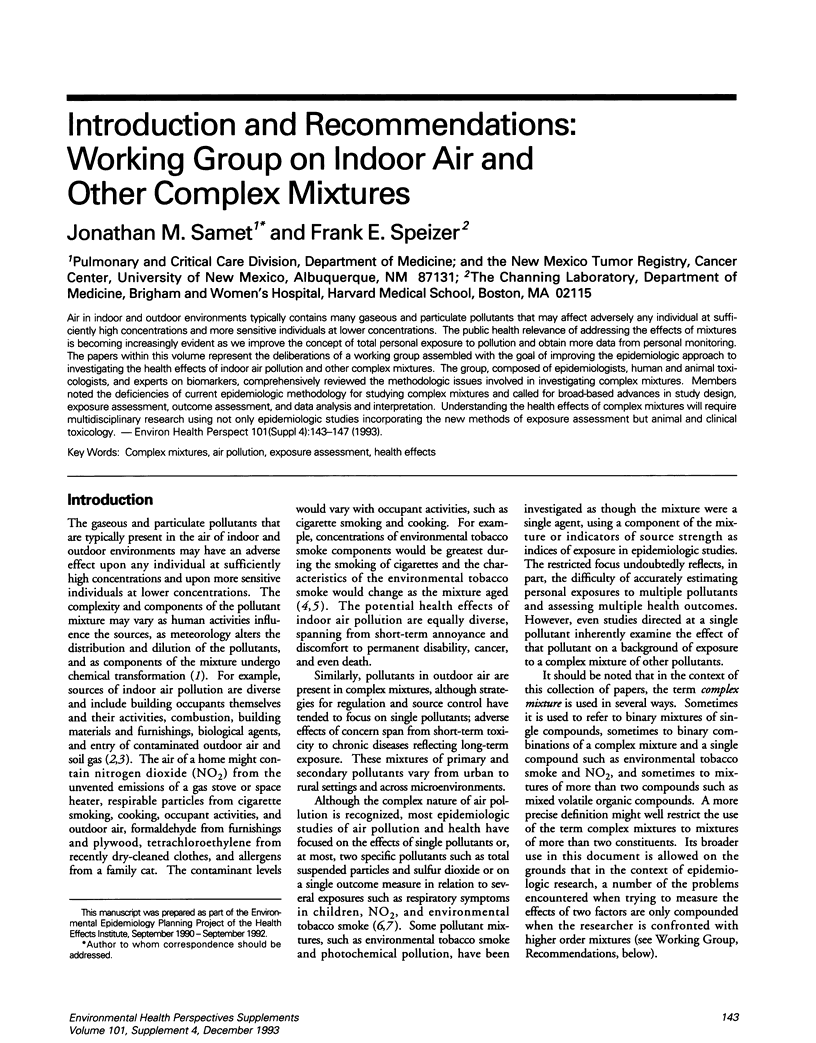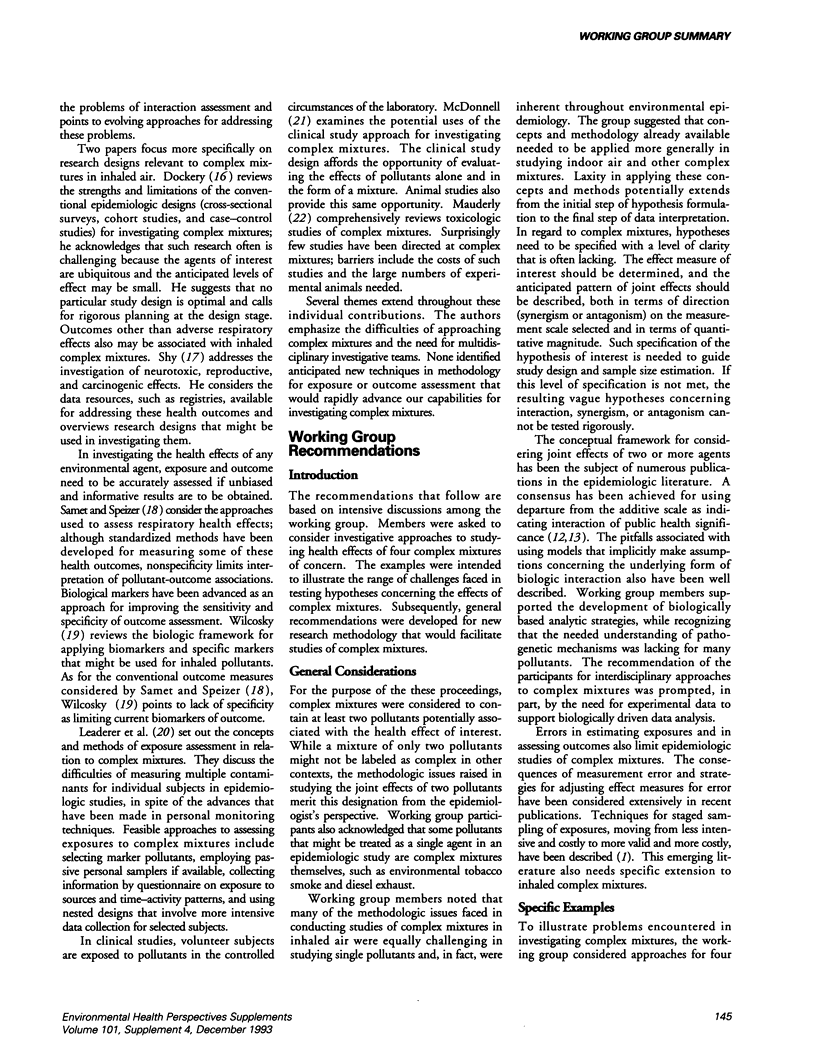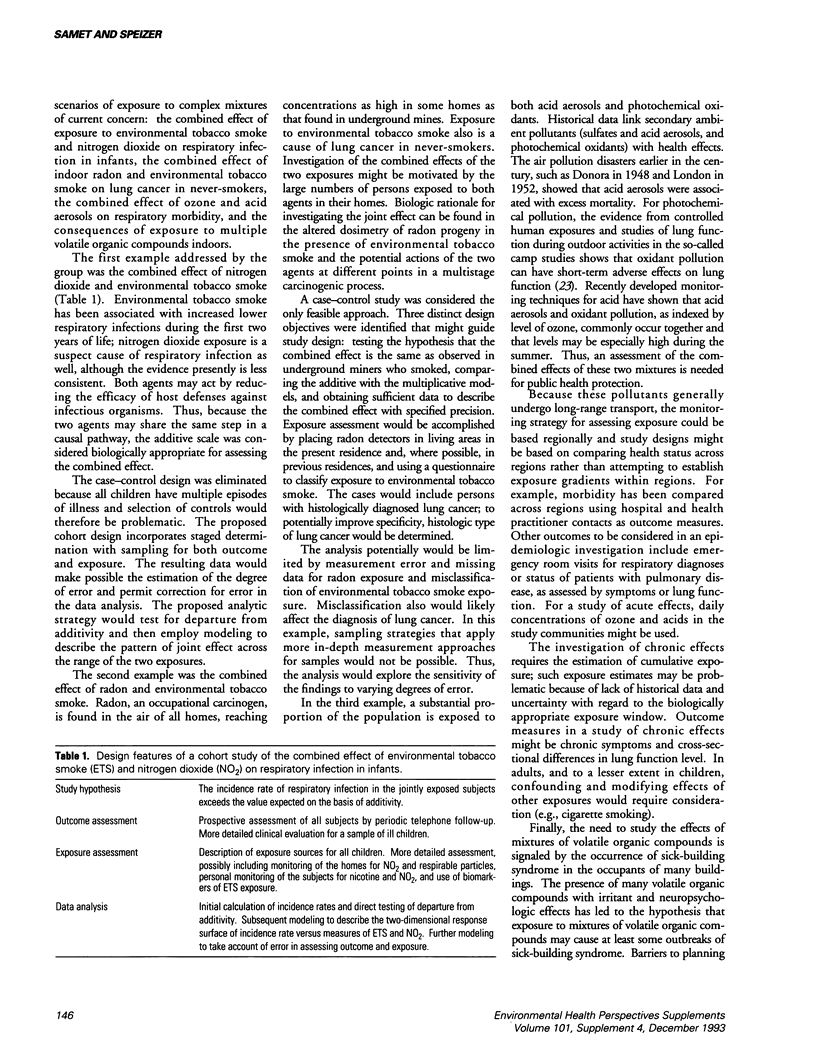Abstract
Air in indoor and outdoor environments typically contains many gaseous and particulate pollutants that may affect adversely any individual at sufficiently high concentrations and more sensitive individuals at lower concentrations. The public health relevance of addressing the effects of mixtures is becoming increasingly evident as we improve the concept of total personal exposure to pollution and obtain more data from personal monitoring. The papers within this volume represent the deliberations of a working group assembled with the goal of improving the epidemiologic approach to investigating the health effects of indoor air pollution and other complex mixtures. The group, composed of epidemiologists, human and animal toxicologists, and experts on biomarkers, comprehensively reviewed the methodologic issues involved in investigating complex mixtures. Members noted the deficiencies of current epidemiologic methodology for studying complex mixtures and called for broad-based advances in study design, exposure assessment, outcome assessment, and data analysis and interpretation. Understanding the health effects of complex mixtures will require multidisciplinary research using not only epidemiologic studies incorporating the new methods of exposure assessment but animal and clinical toxicology.
Full text
PDF




Selected References
These references are in PubMed. This may not be the complete list of references from this article.
- Dockery D. W. Epidemiologic study design for investigating respiratory health effects of complex air pollution mixtures. Environ Health Perspect. 1993 Dec;101 (Suppl 4):187–191. doi: 10.1289/ehp.93101s4187. [DOI] [PMC free article] [PubMed] [Google Scholar]
- Dockery D. W., Speizer F. E., Stram D. O., Ware J. H., Spengler J. D., Ferris B. G., Jr Effects of inhalable particles on respiratory health of children. Am Rev Respir Dis. 1989 Mar;139(3):587–594. doi: 10.1164/ajrccm/139.3.587. [DOI] [PubMed] [Google Scholar]
- Ferris B. G., Jr, Speizer F. E., Spengler J. D., Dockery D., Bishop Y. M., Wolfson M., Humble C. Effects of sulfur oxides and respirable particles on human health. Methodology and demography of populations in study. Am Rev Respir Dis. 1979 Oct;120(4):767–779. doi: 10.1164/arrd.1979.120.4.767. [DOI] [PubMed] [Google Scholar]
- Greenland S. Basic problems in interaction assessment. Environ Health Perspect. 1993 Dec;101 (Suppl 4):59–66. doi: 10.1289/ehp.93101s459. [DOI] [PMC free article] [PubMed] [Google Scholar]
- Leaderer B. P., Lioy P. J., Spengler J. D. Assessing exposures to inhaled complex mixtures. Environ Health Perspect. 1993 Dec;101 (Suppl 4):167–177. doi: 10.1289/ehp.93101s4167. [DOI] [PMC free article] [PubMed] [Google Scholar]
- Mauderly J. L. Toxicological approaches to complex mixtures. Environ Health Perspect. 1993 Dec;101 (Suppl 4):155–165. doi: 10.1289/ehp.93101s4155. [DOI] [PMC free article] [PubMed] [Google Scholar]
- McDonnell W. F. Utility of controlled human exposure studies for assessing the health effects of complex mixtures and indoor air pollutants. Environ Health Perspect. 1993 Dec;101 (Suppl 4):199–203. doi: 10.1289/ehp.93101s4199. [DOI] [PMC free article] [PubMed] [Google Scholar]
- Rothman K. J., Greenland S., Walker A. M. Concepts of interaction. Am J Epidemiol. 1980 Oct;112(4):467–470. doi: 10.1093/oxfordjournals.aje.a113015. [DOI] [PubMed] [Google Scholar]
- Samet J. M., Lambert W. E., Skipper B. J., Cushing A. H., McLaren L. C., Schwab M., Spengler J. D. A study of respiratory illnesses in infants and nitrogen dioxide exposure. Arch Environ Health. 1992 Jan-Feb;47(1):57–63. doi: 10.1080/00039896.1992.9935945. [DOI] [PubMed] [Google Scholar]
- Samet J. M., Marbury M. C., Spengler J. D. Health effects and sources of indoor air pollution. Part I. Am Rev Respir Dis. 1987 Dec;136(6):1486–1508. doi: 10.1164/ajrccm/136.6.1486. [DOI] [PubMed] [Google Scholar]
- Samet J. M., Marbury M. C., Spengler J. D. Health effects and sources of indoor air pollution. Part II. Am Rev Respir Dis. 1988 Jan;137(1):221–242. doi: 10.1164/ajrccm/137.1.221. [DOI] [PubMed] [Google Scholar]
- Samet J. M., Speizer F. E. Assessment of health effects in epidemiologic studies of air pollution. Environ Health Perspect. 1993 Dec;101 (Suppl 4):149–154. doi: 10.1289/ehp.93101s4149. [DOI] [PMC free article] [PubMed] [Google Scholar]
- Shy C. M. Epidemiological studies of neurotoxic, reproductive, and carcinogenic effects of complex mixtures. Environ Health Perspect. 1993 Dec;101 (Suppl 4):183–186. doi: 10.1289/ehp.93101s4183. [DOI] [PMC free article] [PubMed] [Google Scholar]
- Ware J. H., Dockery D. W., Spiro A., 3rd, Speizer F. E., Ferris B. G., Jr Passive smoking, gas cooking, and respiratory health of children living in six cities. Am Rev Respir Dis. 1984 Mar;129(3):366–374. doi: 10.1164/arrd.1984.129.3.366. [DOI] [PubMed] [Google Scholar]
- Weiss N. S. Complex mixtures and indoor air pollution: overview of epidemiologic methods. Environ Health Perspect. 1993 Dec;101 (Suppl 4):179–181. doi: 10.1289/ehp.93101s4179. [DOI] [PMC free article] [PubMed] [Google Scholar]
- Wilcosky T. C. Biological markers of intermediate outcomes in studies of indoor air and other complex mixtures. Environ Health Perspect. 1993 Dec;101 (Suppl 4):193–197. doi: 10.1289/ehp.93101s4193. [DOI] [PMC free article] [PubMed] [Google Scholar]


